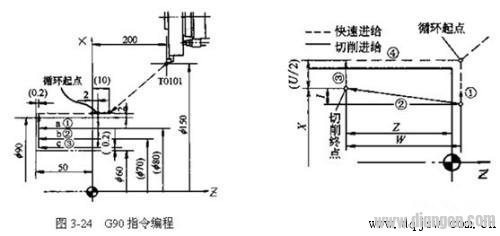When using the G90 command for programming, the workpiece and machining process are illustrated in Figure 3-24. The program is as follows: The format for cutting a cone is G90X(U)__Z(W)__I__(F__). As shown in Figure 3-25, X(U) and Z(W) have the same meaning as before. The I value represents the difference between the radius of the tapered surface and the smaller diameter. The sign of I depends on whether the starting point of the cone has a larger or smaller coordinate than the endpoint.
 This command is typically used when cutting to a specified size without fully machining it, especially during roughing and multi-pass threading operations. There are several types of such commands:
(1) Outer Diameter and Inner Diameter Roughing Cycle Command – G71
This command cuts the workpiece to the dimensions required for finishing. The system automatically sets the shape and roughing tool path based on the final dimensions.
Instruction format: G71 Pns Qnf UΔu WΔw DΔd (F__ S__ T__)
Figure 3-26 shows the machining path for G71 rough turning. In the figure, point C marks the start of the roughing cycle, and point A is where the blank’s outer diameter intersects with the end face contour. When applied to internal cylindrical surfaces, G71 becomes an internal roughing cycle, and Δu should be specified as a negative number.
(2) Face Roughing Cycle Command – G72
This command is suitable for roughing the end face of a cylindrical blank. Its function is similar to G71, but it only focuses on the axial direction. The tool path moves radially. The loop path is shown in Figure 3-27. The instruction format and addresses are the same as G71.
(3) Closed Turning Cycle Command – G73
This command is ideal for roughing when the blank's shape closely matches the final part's contour. It is commonly used for roughing castings or forgings, significantly reducing labor time and improving cutting efficiency. Its function is similar to G71 and G72, but the tool path follows the final contour of the workpiece. The tool path is shown in Figure 3-28.
Instruction format: G73 Pns Qnf IΔi KΔk UΔu WΔw DΔd (F__ S__ T__)
(4) Finishing Cycle Command – G70
Used to execute the finishing cycle after G71, G72, and G73 roughing cycles.
Instruction format: G70 Pns Qnf
The ns and nf in the command have the same meaning as before. During G70 execution, the F, S, and T values specified in the ns to nf program are valid. If these values are not specified in that range, the ones from the roughing cycle will take effect.
This command is typically used when cutting to a specified size without fully machining it, especially during roughing and multi-pass threading operations. There are several types of such commands:
(1) Outer Diameter and Inner Diameter Roughing Cycle Command – G71
This command cuts the workpiece to the dimensions required for finishing. The system automatically sets the shape and roughing tool path based on the final dimensions.
Instruction format: G71 Pns Qnf UΔu WΔw DΔd (F__ S__ T__)
Figure 3-26 shows the machining path for G71 rough turning. In the figure, point C marks the start of the roughing cycle, and point A is where the blank’s outer diameter intersects with the end face contour. When applied to internal cylindrical surfaces, G71 becomes an internal roughing cycle, and Δu should be specified as a negative number.
(2) Face Roughing Cycle Command – G72
This command is suitable for roughing the end face of a cylindrical blank. Its function is similar to G71, but it only focuses on the axial direction. The tool path moves radially. The loop path is shown in Figure 3-27. The instruction format and addresses are the same as G71.
(3) Closed Turning Cycle Command – G73
This command is ideal for roughing when the blank's shape closely matches the final part's contour. It is commonly used for roughing castings or forgings, significantly reducing labor time and improving cutting efficiency. Its function is similar to G71 and G72, but the tool path follows the final contour of the workpiece. The tool path is shown in Figure 3-28.
Instruction format: G73 Pns Qnf IΔi KΔk UΔu WΔw DΔd (F__ S__ T__)
(4) Finishing Cycle Command – G70
Used to execute the finishing cycle after G71, G72, and G73 roughing cycles.
Instruction format: G70 Pns Qnf
The ns and nf in the command have the same meaning as before. During G70 execution, the F, S, and T values specified in the ns to nf program are valid. If these values are not specified in that range, the ones from the roughing cycle will take effect.
1. Glass: Glass insulators are known for their high resistance to electrical conductivity and durability.
2. Porcelain: Porcelain insulators exhibit excellent electrical insulating properties and mechanical strength, making them suitable for various voltage levels.
3. Ceramics: Ceramics, including advanced composite materials, are chosen for their high resistance and ability to withstand harsh environmental conditions.
4. Rubber: Rubber insulators are flexible and provide good electrical insulation, often used in applications where flexibility is required, such as in some types of cables and connectors.
Insulators,Insulator Dead End Polymer,Long Rod Silicone Rubber,Composite Suspension Insulator
Shahe Yipeng Import and Export trading Co., LTD , https://www.yppolelinehardware.com